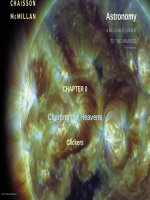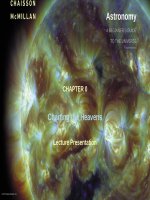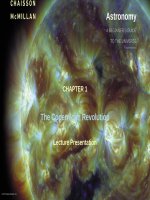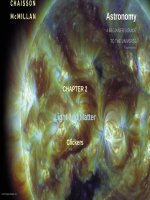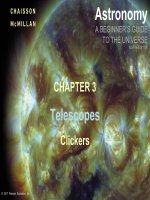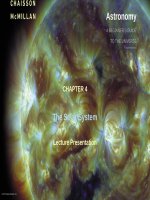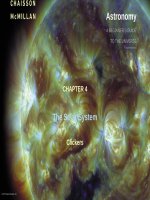Astronomy a beginners guide to the universe 8th CHaisson mcmillan chapter 08 clicker questions
Bạn đang xem bản rút gọn của tài liệu. Xem và tải ngay bản đầy đủ của tài liệu tại đây (2.1 MB, 29 trang )
Astronomy
A BEGINNER’S GUIDE
TO THE UNIVERSE
EIGHTH EDITION
CHAPTER 8
Moons, Rings, and Plutoids
Clickers
© 2017 Pearson Education, Inc.
Question 1
As their distance from Jupiter increases, the four Galilean satellites show a consistent
a)
b)
c)
d)
e)
© 2017 Pearson Education, Inc.
increase in density.
increase in size.
decrease in cratering.
decrease in density.
amount of cratering.
Question 1
As their distance from Jupiter increases, the four Galilean satellites show a consistent
a)
b)
c)
d)
e)
increase in density.
increase in size.
decrease in cratering.
decrease in density.
amount of cratering.
Explanation: Like a miniature
version of our solar system,
Jupiter’s four large moons show a decrease in density as distance increases. Io is most dense of the four; Callisto
is least dense.
© 2017 Pearson Education, Inc.
Question 2
The surface of which jovian moon most resembles the pack ice of the Arctic Ocean?
a)
b)
c)
d)
e)
© 2017 Pearson Education, Inc.
Europa
Io
Amalthea
Ganymede
Callisto
Question 2
The surface of which jovian moon most resembles the pack ice of the Arctic Ocean?
a)
b)
c)
d)
e)
Europa
Io
Amalthea
Ganymede
Callisto
Explanation: Ice-filled surface cracks
indicate an ocean may lie below.
© 2017 Pearson Education, Inc.
Question 3
What is thought to cause Io’s volcanism?
a)
b)
c)
Jupiter’s magnetosphere
Jupiter’s rapid rotation
Tidal stress from Jupiter
and Europa
d)
Radioactive decay from
its core
e)
Io’s large mass and
tectonic activity
© 2017 Pearson Education, Inc.
Question 3
What is thought to cause Io’s volcanism?
a)
b)
c)
Jupiter’s magnetosphere
Jupiter’s rapid rotation
Tidal stress from Jupiter
and Europa
d)
Radioactive decay from
its core
e)
Io’s large mass and
tectonic activity
Explanation: Io is constantly “squeezed” by its huge neighbor as well as by companion moons, heating its interior.
© 2017 Pearson Education, Inc.
Question 4
How was the ring of Jupiter discovered?
a)
By optical telescopic
observers from Earth
b)
By Voyager I as it
passed Jupiter
c)
d)
By an occultation of a star
By radar imaging using the
Arecibo dish
e)
© 2017 Pearson Education, Inc.
With the Hubble Space Telescope’s superior resolution
Question 4
How was the ring of Jupiter discovered?
a)
By optical telescopic
observers from Earth
b)
By Voyager I as it
passed Jupiter
c)
d)
By an occultation of a star
By radar imaging using the
Arecibo dish
e)
With the Hubble Space Telescope’s superior resolution
Explanation: Jupiter’s ring is composed of dark, dusty particles that were first seen when Voyager was past the
planet, looking back toward the Sun.
© 2017 Pearson Education, Inc.
Question 5
The Roche limit is defined as the critical
a)
b)
c)
distance from a planet, inside of which a moon can be tidally destroyed.
density that a moon can have and be solid.
distance from a planet that
a moon can experience
synchronous rotation.
d)
mass a moon can have and
still be classified as a moon.
© 2017 Pearson Education, Inc.
Question 5
The Roche limit is defined as the critical
a)
b)
c)
distance from a planet, inside of which a moon can be tidally destroyed.
density that a moon can have and be solid.
distance from a planet that
a moon can experience
synchronous rotation.
d)
mass a moon can have and
still be classified as a moon.
Explanation: Saturn’s rings, as
well as those of the other jovian
planets, lie within its planet’s Roche limit.
© 2017 Pearson Education, Inc.
Question 6
Shepherd satellites are defined as
a)
b)
c)
satellites in the coma of a comet.
moons that confine a narrow ring.
a type of moon that orbits another
moon.
d)
moons that share an orbit
of another, larger moon.
e)
moons that orbit inside a
system of rings.
© 2017 Pearson Education, Inc.
Question 6
Shepherd satellites are defined as
a)
b)
c)
satellites in the coma of a comet.
moons that confine a narrow ring.
a type of moon that orbits another
moon.
d)
moons that share an orbit
of another, larger moon.
e)
moons that orbit inside a
system of rings.
© 2017 Pearson Education, Inc.
Question 7
Why are the rings of Saturn so bright?
a)
They are made of frozen
metallic hydrogen.
b)
They contain glassy beads
expelled by volcanoes on
Enceladus.
c)
d)
They contain shiny bits of iron.
Titan and other moons reflect
an additional glow onto the rings.
e)
© 2017 Pearson Education, Inc.
They are made of relatively new ice.
Question 7
Why are the rings of Saturn so bright?
a)
They are made of frozen
metallic hydrogen.
b)
They contain glassy beads
expelled by volcanoes on
Enceladus.
c)
d)
They contain shiny bits of iron.
Titan and other moons reflect
an additional glow onto the rings.
e)
They are made of relatively new ice.
Explanation: Saturn’s rings are perhaps only 50 million years old, the result of a small moon coming within the
planet’s Roche limit.
© 2017 Pearson Education, Inc.
Question 8
Which moon in the solar system shows a dense atmosphere?
a)
b)
c)
d)
e)
© 2017 Pearson Education, Inc.
Our Moon
Phobos
Europa
Titan
Triton
Question 8
Which moon in the solar system shows a dense atmosphere?
a)
b)
c)
d)
e)
Our Moon
Phobos
Europa
Titan
Triton
Explanation: The Huygens probe,
deployed by the Cassini spacecraft
in 2005, showed that Titan’s
atmosphere has a complex organic
chemistry.
© 2017 Pearson Education, Inc.
Question 9
Which of the Uranian moons displays the widest range of
surface terrains, suggesting some catastrophic disruption?
a)
b)
c)
d)
e)
© 2017 Pearson Education, Inc.
Puck
Umbriel
Oberon
Miranda
Ariel
Question 9
Which of the Uranian moons displays the widest range of
surface terrains, suggesting some catastrophic disruption?
a)
b)
c)
d)
e)
© 2017 Pearson Education, Inc.
Puck
Umbriel
Oberon
Miranda
Ariel
Question 10
The rings of Neptune
a)
b)
c)
d)
e)
© 2017 Pearson Education, Inc.
were confirmed by Voyager 2 in 1989.
appear both narrow and diffuse.
all lie within Neptune’s Roche limit.
often appear as clumpy ring arcs, rather than complete and symmetrical rings.
All of these are correct.
Question 10
The rings of Neptune
a)
b)
c)
d)
e)
© 2017 Pearson Education, Inc.
were confirmed by Voyager 2 in 1989.
appear both narrow and diffuse.
all lie within Neptune’s Roche limit.
often appear as clumpy ring arcs, rather than complete and symmetrical rings.
All of these are correct.
Question 11
Neptune’s moon Triton shows
a)
b)
c)
d)
e)
© 2017 Pearson Education, Inc.
a thick atmosphere similar to Titan.
volcanic features similar to those on Io.
cratering similar to that of Callisto.
large cliffs similar to Miranda.
All of the above are correct.
Question 11
Neptune’s moon Triton shows
a)
b)
c)
a thick atmosphere similar to Titan.
volcanic features similar to those on Io.
cratering similar to that
of Callisto.
d)
e)
large cliffs similar to Miranda.
All of the above are correct.
Explanation: Triton has a thin
atmosphere, active geysers of nitrogen
gas, large fissures, and frozen lakes of
water ice.
© 2017 Pearson Education, Inc.
Question 12
Many astronomers believe Pluto is perhaps best
classified as a
a)
b)
c)
d)
e)
© 2017 Pearson Education, Inc.
cold terrestrial planet.
small jovian planet.
large Kuiper belt object.
wandering moon.
captured comet.
Question 12
Many astronomers believe Pluto is perhaps best
classified as a
a)
b)
c)
d)
e)
cold terrestrial planet.
small jovian planet.
large Kuiper belt object.
wandering moon.
captured comet.
Explanation: Several other large Kuiper belt objects have been discovered, including the largest known, called
Eris.
© 2017 Pearson Education, Inc.
